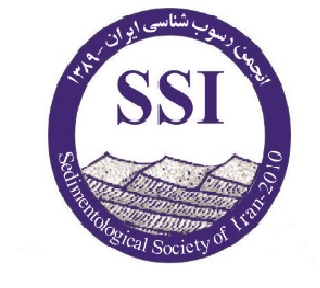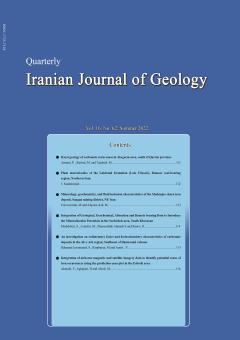An investigation on sedimentary facies and hydrochemistry characteristics of carbonate deposits in the Ab-e Ask region, Southeast of Damavand volcano
Subject Areas :S. Rahmani Javanmard 1 , Mohsen Ranjbaran 2 , V. Amiri 3
1 -
2 - Tehran University
3 - Yazd University
Keywords: Ab-e Ask, Carbon and oxygen stable isotopes, Thermogene travertines, Sedimentary facies, Hydrochemistry.,
Abstract :
Calcareous springs of Ab-e Ask are located 85 km northeast of Tehran, in the southern range of the Damavand volcano. Microscopic studies represent the existence of four abiotic and two microbialite facies in the Ab-e Ask travertines. The travertines are the main deposit types of these springs. Based on sedimentation sequence and lithofacies these travertines are categorized as first type (vent and channel), second type (pound, dam, and cascade), and third type (laminated) travertines. On a δ18O versus δ13C plot (VPDB), these travertines are plotted in the oncoid and crystalline crust lithofacies fields. These facies show the character of hydrothermal spring and set the spring in the thermogenic group. Positive values of the Langelier Saturation Index (LSI) for Pashnak, Nadaali, and Zagh springs indicate that these water samples are supersaturated with respect to calcium carbonate, which leads to considerable sedimentation around the springs. In contrast, a negative LSI value at the Sare Pole spring indicates the water is undersaturated with respect to calcium carbonate. Therefore, this spring has a lesser role in travertine deposition compared to the other springs. Also, the position of the samples on the modified Gibbs and Van Wirdum diagrams, suggests that the interaction of water with carbonate and to some extent silicate rocks is considered as the most important source of Ca and Na.
اسکویی، ب. و امیدیان، ص.، 1393. بررسي ساختاري گسلهاي ايرا و نوا در جنوب شرق آتشفشان دماوند با استفاده از روش مغناطيس سنجي. مجله فیزیک زمین و فضا، 2، 83-96.
- امیدیان، ص.، 1386. تعیین جایگاه زمینساختی آتشفشان دماوند بر اساس شواهد ساختاری و ژئوشیمیایی. پایاننامه کارشناسی ارشد، دانشکده زمینشناسی، دانشگاه تهران، 167.
- رحمانی جوانمرد، س.، 1390. مطالعه زايش و ژنز تراورتنهاي آب اسک در شرق آتشفشان دماوند با بهرهگيري از نسبتهای ايزوتوپي، پتروگرافي و دورسنجی. پایاننامه کارشناسی ارشد، دانشکده زمینشناسی، دانشگاه تهران، 158.
- رحيمپور بناب، حسين.، 1384. سنگشناسي کربناته، ارتباط دياژنز و تكامل تخلخل. انتشارات دانشگاه تهران، 487.
- Allen, M., Ghassemi, M.R., Shahrabi, M. and Qorashi, M., 2003. Accommodation of late Cenozoic oblique shortening in the Alborz range, northern Iran. Journal of Structural Geology, 25, 659–672.
- Allenbach, P. and Shteiger, R., 1966. Geological map of Damavand, scale 1:100 000, 1 sheet. Tehran, Iran: Geological Survey of Iran.
- Amiri, V. and Berndtsson, R., 2020. Fluoride occurrence and human health risk from groundwater use at the west coast of Urmia Lake, Iran. Arabian Journal of Geosciences, 13, 921.
- Amiri, V., Bhattacharya, P. and Nakhaei, M., 2021a. The hydrogeochemical evaluation of groundwater resources and their suitability for agricultural and industrial uses in an arid area of Iran. Groundwater for Sustainable Development, 12, 100527.
- Amiri, V., Li, P., Bhattacharya, P. and Nakhaei, M., 2021b. Mercury pollution in the coastal Urmia aquifer in northwestern Iran: potential sources, mobility, and toxicity. Environmental Science and Pollution Research, 28, 17546–17562.
- Amiri, V., Nakhaei, M., Lak, R. and Li, P., 2021c. An integrated statistical-graphical approach for the appraisal of the natural background levels of some major ions and potentially toxic elements in the groundwater of Urmia aquifer, Iran. Environmental Earth Sciences, 80, 1–17.
- Ansari, M.R., 2013. Hydrochemistry of the Damavand Thermal springs, North of Iran. Life Science Journal, 10(7s), 866–873.
- Braithwaite, C., 1979. Crystal textures of recent fluvial pisolites and laminated crystalline crusts in Dyfed, South Wales. Journal Sedimentary Petrology, 49, 181–194.
- Chafetz, H.S., Wilkinson, B.H. and Love, K.M., 1985. Morphology and composition of nonmarine carbonate cements in near-surface settings: In: Schneidermann, N., and Harris, P.M., eds., Carbonate cements, Society of Economic Paleontologists and Mineralogists, 36, 337–347.
- Chafetz H.S. and Folk, R.L., 1984. Travertines: depositional morphology and the bacterially constructed constituents. Journal of Sedimentary Petrology, 54, 289–316.
- Chafetz, H.S. and Meredith J.C., 1983. Recent travertine pisolites (pisoids) from southeastern Idaho, U.S.A. 450–455. In: Peryt TM (ed) Coated Grains. New York, Springer-Verlag, 655.
- Chon, F., 1864. Uber die Entstehung des travertine in der Wasserfallen von Tivoli. Neues Jahrbuch fur Mineralogie, Geologie und Palaeontilogie Abhandlung, 40, 580–610.
- Cipriani, N., Ercoli, A., Malesani, P. and Vannucci, S., 1972. I travertini di Rapolano Terme. Memorie della Società Geologica Italiana, 11, 31–46.
- Domenico, P.A. and Schwartz, F.W., 1990. Physical and chemical hydrogeology. John Wiley and Sons, New York, 824.
- Esmaeili-Vardanjani, M., Rasa, I., Amiri, V., Yazdi, M. and Pazand, K., 2015. Evaluation of groundwater quality and assessment of scaling potential and corrosiveness of water samples in Kadkan aquifer, Khorasan-e-Razavi Province, Iran. Environmental monitoring and assessment, 187, 1–18.
- Folk, R.L., Chafetz, H.S. and Tiezzi, P.A., 1985. Bizarre forms of depositional and diagenetic calcite in hot-spring travertines, central Italy. In Carbonate cements. Edited by N. Schneidermann and P.M. Harris. SEPM (Society of Economic Paleontologists and Mineralogists), Special Publication 36, 349–369.
- Fouke, B.W., Bonheyo G. T., Sanzenbacher B. and Frias-Lopez J., 2003. Partitioning of bacterial communities between travertine depositional facies at Mammoth Hot Springs, Yellowstone National Park, USA. Canadian Journal Earth Sciences, 40, 1531–1548.
- Fouke, B.W., Farmer, J.D., Des Marais, D.J., Pratt, L., Sturchio, N.C., Burns, P.C. and Discipulo, M.K., 2001. Reply-Depositional facies and aqueous-solid geochemistry of travertine-depositing hot springs (Angel Terrace, Mammoth Hot Springs, Yellowstone National Park, USA). Journal of Sedimentary Research, 71, 497–500.
- Fouke, B.W., Farmer, J.D., Des Marais, D.J., Pratt, L., Sturchio, N.C., Burns, P.C. and Discipulo, M.K., 2000. Depositional facies and aqueous-solid geochemistry of travertine-depositing hot springs (Angel Terrace, Mammoth Hot Springs, Yellowstone National Park, U.S.A). Journal of Sedimentary Research, 70, 565–585.
- Freytet, P. and Plet, A., 1996. Modern freshwater microbial carbonates: The Phormidium stromatolites (Tufa-Travertine) of southeastern Burgundy (Paris basin, France). Facies, 34, 219– 237.
- Gandin, A. and Capezzuoli, E., 2014. Travertine: distinctive depositional fabrics of carbonates from thermal spring systems. Sedimentology, 61, 264–290.
- Gandin, A. and Capezzuoli, E., 2008. Travertine versus calcareous tufa: distinctive petrologic features and related stable isotopes signature. Italian Journal of Quaternary Sciences, 21, 125–136.
- Geurts, M.A., Frappier, M. and Tsien, H.H., 1992. Morphogenèse des barrages de travertin de Coal River Springs, Sud-est du territoire du Yukon, Geographie physique et quaternaire, 46, 221–232.
- Gibbs, R.J., 1970. Mechanisms controlling world water chemistry. Journal of Science, 17, 1088–1090.
- Gonfiantini, R., Panichi, C. and Tongiorgi, E., 1968. Isotopic disequilibrium in travertine deposition. Earth Planetary Sciences Letter, 5, 55–58.
- Gruszczynski, M., Kowalski, B.J., Soltysik, R. and Hercman H., 2004. Tectonic origin of the unique Holocene travertine from the Holy Cross Mts.: microbially and abiologically mediated calcium carbonate, and manganese oxide precipitation. Acta Geologica Polonica, 54, 61–76.
- Guo, L. and Riding, R., 1998. Hot-spring travertine facies and sequences Late Pleistocene, Rapolano Terme, Italy. Sedimentology, 45, 163–180.
- Hassanzadeh, J., Omidian, S. and Davidson, J., 2006. A late Pliocene tectonic switch from transpression to transtension in the Haraz sector of central Alborz: implications for the origin of Damavand volcano. Philadelphia Annual Meeting, Geological Society of America, 171–28.
- Inskeep, W.P. and McDermott, T.R., 2005. Geomicrobiology of acid-sulfate-chloride springs in Yellowsotne National Park. In: Geothermal Biology and Geochemistry in Yellowstone National Park (Eds W.P.Inskeep and T.R.McDermott), 143–162. Montana State University Publications, Bozeman.
- Janssen, A., Swennen, R., Podoor, N. and Keppens, E., 1999. Biological and diagenetic influence in recent and fossil tufa deposits from Belgium, Sedimentary Geology, 126, 75–95.
- Jones, B. and Renaut ,R.W., 2010. Calcareous spring deposits in continental settings. In: Continental Settings: Facies, Environments and Processes. (Eds A.M. AlonsoZarza and L.H. Tanner), Elsevier, Amsterdam. 177–224.
- Kele, S., Demeny, A., Siklosy, Z., Nemeth, T., Maria, T. and Kovacs M.B., 2008. Chemical and stable isotope compositions of recent hot-water travertines and associated thermal waters, from Egerszalók, Hungary: depositional facies and non-equilibrium fractionations. Sedimentary Geology, 211, 53–72.
- Kitano, Y., 1962. A study of the polymorphic formation of calcium carbonate in thermal springs with an emphasis on the effect of temperature. Bulletin of the Chemical Society of Japan, 35, 1980–1985.
- Lippmann, F., 1973. Sedimentary carbonate minerals. Springer-Verlag, Heidelberg–New York, 228.
- Love, K.M. and Chafetz, H.S., 1988. Diagenesis of laminated travertine crusts, Arbuckle Mountains, Oklahoma. Journal of Sedimentary Research, 58, 441–445.
- Mohanty, M. and Das, S., 1997. Microbial signatures in lacustrine and fluvial carbonates; In: Gondwana (Permian) and Holocene examples India. Facies, 36, 234–238.
- Monty, C.L.V., 1976. The origin and development of cryptalgal fabrics. In: Walter, M.R. (Ed.), Stromatolites. Developments in Sedimentology, 20, 193–249. Elsevier, Amsterdam.
- Nelson J., 1990. Experimental investigation of control on cementation on carbonates. Journal of the Geological Society (London), 147, 949–958.
- Özkul, M., Varol, B. and Alçiçek, M. C., 2002. Depositional environments and petrography of Denizli travertines. Bulletin of the Mineral Research and Exploration, 125, 13–29.
- Pedley, H.M., 1987. The Flandrian (Quaternary) Caerwys tufa, North Wales: an ancient barrage tufa deposit. Proceedings of the Yorkshire Geological Society, 46, 141–152.
- Pentecost, A., 2005b. Travertine. Berlin, Heidelberg: Springer-Verlag, 446
- Pentecost, A., 1995a. The microbial ecology of some Italian hot-spring travertines. Microbios, 81, 45–58.
- Pentecost, A., 1995b. Significance of the biomineralizing microniche in a lyngbya (cyanobacterium ) travertine. Geomicrobiology Journal, 13, 213–222.
- Pentecost, A. and Viles, H., 1994. A review and reassessment of travertine classification. Geographie physique et Quaternarie, 48, 305–314.
- Rahmani Javanmard, S., Tutti, F., Omidian, S. and Ranjbaran, M., 2012. Mineralogy and stable isotope geochemistry of the Ab Ask travertines in Damavand geothermal field, Northeast Tehran, Iran. Central European Geology, 55, 187–212.
- Ranjbaran, M., Rahmani Javanmard, S. and Sotohian, F., 2019. Petrography and Geochemistry of Quaternary travertines in the Ab-Ask region, Mazandaran Province- Iran. Geopersia, 9, 351–365.
- Roshanak, R., Zarasvandi, A.R., Pourkaseb, H. and Moore, F., 2018. Investigations on Northern Urmia-Dokhtar travertines and comparison with north Sanandaj-Sirjan travertines using 18O and 13C stable isotopes. Geosciences Journal, 27, 143–152 (in Persian with English abstract).
- Sanders, J.E. and Friedman, G.M., 1967. Origin and occurrence of limestones. In: Chillingar, G.V., Bissel, H.J. and Fairbridge, R.W., (Eds), Carbonate Rocks, 169–265.
- Tanaskovic, I., Golobocanin, D. and Miljevic, N., 2012. Multivariate statistical analysis of hydrochemical and radiological data of Serbian spa waters. Journal of Geochemical Exploration, 112, 226–234.
- Turi, B., 1986. Stable isotope geochemistry of travertines, in: Fritz, P., Fontes, J.Ch. (Eds.), Handbook of Environmental Isotope Geochemistry, 2. Elsevier, Amsterdam, 207–238.

